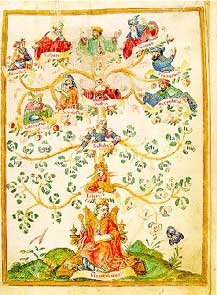
|
|
|
| History of Portuguese Literature | Origins of Portuguese Literature | The Portuguese Language | Oral Literature | Fiction | Lyricism |
| Travel Literature | Cantigas de amigo | Historiography | Doctrinal Prose | ||
The Portuguese Language
|
|
The
Portuguese language derives from Latin,
a language spoken by the inhabitants of the region around ancient Rome, known as
Latium. With the expansion of their territory, the Romans brought this language
to other regions, where, in conjunction with local factors, it evolved in
different ways and gave rise to the Romance
languages.
Over time, Classical Latin, which had
already established itself as the language of the educated classes and
literature, became far removed from its spoken expression. The latter
incorporated various influences from the different territories of the Roman
Empire, as well as socio-cultural varieties. All these together were referred to
as Vulgar Latin, and this gave rise to the Romance languages and, in our
particular case, Portuguese.
 The Tree of Grammar in Grammatices Rudimenta (c. 1540) by João de Barros |
Linguistic
communication began to alter gradually and, instead of people in fact speaking
in Latin, the changes in their mode of expression brought them the awareness
that they had in fact begun to speak in the “Romanic way” (i.e. they had
begun to speak Romanice or Romance
(a vulgar and mixed way of talking, also referred to here in Portugal as Romanço). For administrative and notarial written texts, a set of
formulas were introduced that were identified as Barbarous Latin. In the formation of the Portuguese language, the
Latin base also incorporated features of the Celtic, Greek and Hebrew languages,
to which Germanic and Arabic elements were later added.
We may consider three phases in the evolution of the Portuguese language: the proto-historic
phase, until the thirteenth century (a phase when there were still very close
connections in written terms with Barbarous Latin), the archaic
phase, until the sixteenth century (a phase in which, in the fourteenth and
fifteenth centuries, one of the most important developments was the
Galician-Portuguese language, with Portuguese later acquiring its own autonomy
in relation to Galician) and the modern
phase, with the publication of the first grammar books, by Fernão de Oliveira, 1536, and João
de Barros, 1540, and the proliferation of literary works that helped to
establish its reputation, and amongst these was, of course, Camões’ epic poem
Os Lusíadas (The Lusiads).
In
terms of the phonation of the Portuguese language, its formal characteristics
are considered to consist of the phenomena of nasalisation (the dropping of
Latin consonants and their replacement by nasal diphthongs, e.g. the -ão
and -ãe sounds, and vowels with the same tonal quality, e.g. panes
> pães), vocalisation (the dropping of Latin consonants and their
replacement by vowels, e.g. regnu >
reino) and palatalisation (groups of Latin consonants resulting in the ch- and lh- groups, e.g. pluvia
> chuva).
In 1945, in his book Estilística da Língua
Portuguesa, Rodrigues Lapa
studied some of the expressive potentialities of the Portuguese language in both
communication and literature.
© Instituto Camões, 2001